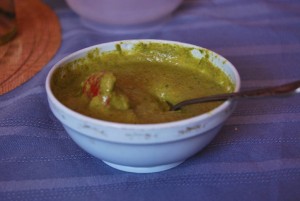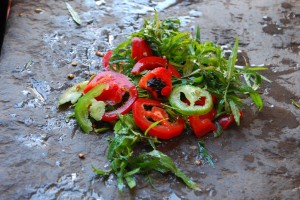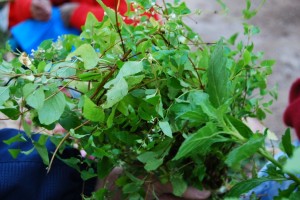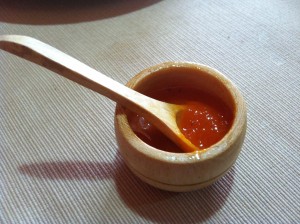A Different and Subtle Cuzco Hot Sauce

On Mothers Day, while the men in the garden struggled to get the heat right to grill large, thin pork chops, I walked into the kitchen to see how Doña Mercedes was. She was busy charring sach’a tomates (also called tree tomato, tomato with a tail, tamarillo, or solanum betaceum). After we chuckled that it was Mothers Day and still she was cooking even though the men thought they were making the meal, I asked her what she was making and she said she was making an ají a hot sauce for the meal.
Hot sauces are very common and quite varied here in Peru. Every family and restaurant have their own repertoire of ajíes, although the techniques are similar. As a result there is a seeming infinite variety of sauces, each using hot peppers, to bring about a a range of flavors that can complement almost every dish.
Knowing this, I was excited to watch Doña Mercedes make her ají, even though it was a day for her to rest and receive honor from her children and husband. The subtleties of technique can make such a difference in the resulting product.

She had speared the sach’a tomates with a fork and was turning them over the open flame of her gas range. This is a process that in Peru is called soazar with a subtle addition of so- to the word azar which is the more standard Spanish word for roasting.
Doña Mercedes said that charring the tamarillos’ skin like this not only made it easier to peel it gave the fruit a bit of smokiness and sweetness. She said that people here will often do something like this as part of making a jam from the tomatoes with a tail.

Once the skin was blackened, she peeled it off and then placed the torpedo like fruit in a blender. In total she roasted three small tamarillos.

The sach’a tomate, which means wild tomato, is not easily found in the United States and probably not in Northern Europe either. It is a large bush which produces these relatives of our domestic tomato. They have a taste that is tarter and even a bit sweet, strangely. If one cannot find them, one could probably obtain a similar result by roasting a full flavored regular tomato and maybe a Mexican tomatillo, working the proportions to get the most pleasing taste.
On the side board, Doña Mercedes had a large rocoto that was yellow. Often these are red, although not infrequently they are yellow too. The version sold in Mexican markets in the United States is called chile manzano. It is the same species and has a similar taste. But Doña Mercedes’ rocoto was the size of a medium red pepper. Seldom does one find chiles manzanos of that size in the US. You would have to use several to attain the same proportion, though beware because these are very hot peppers though their flavor is wonderful and necessary for this sauce. Beyond their heat they give a certain tang.

Doña Mercedes sliced the pepper into big chunks and placed in a small frypan over medium flame with a bit of oil to soften. To this she added two cloves of garlic also cut into chunks as well as a small, sliced red onion. All of these she turned and sauteed to ensure they softened uniformly. When ready she turned them and the bit of flavorful oil into the blender on top of the sach’a tomates, filling it almost two thirds of the way up.
She told me that if, once blended, the sauce was too liquid, one could add crust-free, slices of dried bread to thicken the sauce to a creamy consistency.
In the meantime, Doña Mercedes pulled out of her shopping bag an asnapa, a bundle of herbs as they are sold in the market. It includes sprigs of oregano, parsley, cilantro, rue, mint, and of course huacatay–also called black mint in the US and available in jarred form in Peruvian and some Mexican stores in the US, or online.

Unfortunately, I was called away then for a minute and did not see the next step. But she chunked some white, fresh cheese, like paneer in Indian markets, homemade cheese, farmer’s cheese, or a Mexican queso fresco. She added these and a handful of huacatay to the sauce, and blended it into a thick, light green cream.
“In Cuzco,” she told me, “they call this sauce llantén.” It is also called uchukuta, which is Quechua for hot sauce. The last time I saw her make llantén, she used a raw rocoto, fresh huacatay, and bread. The resulting sauce was thick and strong, perfect for accompanying roast pork.
This time, it was lighter and far more complex in flavor, with the background sourness of the tomatoes with tails balanced by the creamy cheese giving it a light dairy quality. It was not as hot, though it had a lot of pepper. The sautéeing probably softened the pepper’s heat.

The sauce was a revelation. The name was the same as before and the huacatay was the same, but the rest differed, both in technique and the addition of the tamarillos.
Though I love the flavor of huacatay, it is overwhelming, sometimes, and I wondered how this sauce would taste without that herb. It would have been a light orange or pinkish color and I bet it would have been fantastic.
As it was, the sauce perfectly matched the white meat of the thin pork chops cooked over a flame on a griddle as well as baked potatoes from an earthen oven, called huatia.

Peru is a land of amazing peppers. They originated here and there are many species, each different in flavor and heat from the others, while in north America we only get a few peppers. But the technique and accompanying ingredients, such as tomatoes, sach’a tomates, cheese, bread, or seasonings, can make individual sauces that express a rainbow of flavors to combine with a palette of different dishes.
Note: Unfortunately, I did not have a camera with me and so could only record this process through words. The pictures combined with this note are only to break up the space of the page. They are not here to illustrate this hot sauce of which I have no visual record. Cheers.




